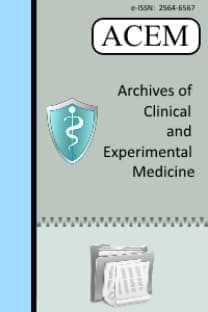Surgicel ® kullanımının epistaksis kontrolünde nazal tampon ile karşılaştırılması
Nazal tampon, epistaksis, burun kanaması
Comparing efficacy of Surgicel ® application with nasal packing in epistaxis
Nasal packing, epistaxis, nasal bleeding,
___
- 1. Pallin D, Chng Y, McKay M, Emond J, Pelletier A, Camargo C. Epidemiology of epistaxis in US emergency departments 1992 to 2001. Ann Emerg Med. 2005;46:77–81.
- 2. Vhichweg T, Roberson J, Hudson J. Epistaxis: diagnosis and treatment. J Oral Maxillofac Surg. 2006; 64:511–8.
- 3. Ha J, Hodge J, Lewis R. Comparison of nasendoscopic-assisted cautery versus packing for the treatment of epistaxis. ANZ J Surg. 2011;81:336-9.
- 4. Bahreini M, Jalili M, Morafi-Lakeh M. A comparison of three self-reported pain scales in adults with acute pain. J Pain. 2013;14:1653-62.
- 5. Duncan I, Fourie P, Ic Grange C, Van der Walt H. Endovascular treatment of intractable epistaxis results of a 4 year local audit. S Afr Med J. 2004;94:373-8.
- 6. McGarry G, Moulton C. The first aid management of epistaxis by accident and emergency department staff. Arc of Emerg Med.1993;10:290-300.
- 7. Farneti P, Pasquini E, Sciarretta V, Macrì G, Gramellini G, Pirodda A. Comparison of Local Sclerotherapy With Lauromacrogol Versus Nasal Packing in the Treatment of Anterior Epistaxis. Clin Exp Otorhinolaryngol. 2016; 9:131-5.
- 8. Kucik CJ, Clenney T. Management of epistaxis. Am Fam Physician. 2005;71:305–11.
- 9. Morgan DJ, Kellerman R. Epistaxis: evaluation and treatment. Prim Care. 2014;41:63–73.
- 10. Toner JG, Walby AP. Comparison of electro and chemical cautery in the treatment of anterior epistaxis. J Laryngol Otol. 1990;104:617–8.
- 11. Stangerup SE, Dommerby H, Lau T. Hot water irrigation as a treatment of posterior epistaxis? Rhinology. 1996;34:18-20.
- 12. Meric A, Korkut AY, Kahya V, Gedikli O. Prospective, randomized, controlled clinical trial of Ankaferd Blood Stopper in patients with acute anterior epistaxis. Eur Arch Otorhinolaryngol. 2010; 267:1377–81.
- 13. Certal V, Silva H, Santos T, Correia A, Carvalho C. Trans-septal suturing technique in septoplasty: a systematic review and meta-analysis. Rhinology. 2012;50:236-45.
- 14. Zayyan E, Bajin MD, Aytemir K, Yılmaz T. The effects on cardiac functions and arterial blood gases of totally occluding nasal packs and nasal packs with airway. Laryngoscope. 2010;120:2325-30.
- 15. Dubin MR, Pletcher SD. Postoperative packing after septoplasty: is it necessary? Otolaryngol Clin North Am. 2009;42:279-85.
- 16. Al-Shaikh S, Muddaiah A, Lee RJ, Bhutta MF. Oxidised cellulose powder for haemostasis following sinus surgery: a pilot randomised trial. J Laryngol Otol. 2014;128:709-13.
- 17. Valentine R, Wormald PJ, Sindwani R. Advances in absorbable biomaterials and nasal packing. Otolaryngol Clin North Am. 2009;42:813-28.
- 18. Lewis KM, Spazierer D, Urban MD, Lin L, Redl H, Goppelt A. Comparison of regenerated and non-regenerated oxidized cellulose hemostatic agents. Eur Surg. 2013;45:213-20.
- 19. Bhatnagar RK, Berry S. Selective Surgicel ® packing for the treatment of posterior epistaxis. Ear Nose Throat J. 2004;83:633-4.
- 20. Günaydın RÖ, Aygenc E, Karakullukcu S, Fidan F, Celikkanat S. Nasal packing and transseptal suturing techniques: surgical and anaesthetic perspectives. Eur Arch Otorhinolaryngol. 2011;268:1151-6.
- 21. Certal V, Silva H, Santos T, Correia A, Carvalho C. Trans-septal suturing technique in septoplasty: a systematic review and meta-analysis. Rhinology. 2012;50:236-45.
- 22. Wysocki J, Niszczota CS. Use of trans-septal mattress suture of Little's area for anterior epistaxis. J Laryngol Otol. 2011;125:399-401.
- 23. Newton E, Lasso A, Petrcich W, Kilty S.J. An outcomes analysis of anterior epistaxis management in the emergency department. J Otolaryngol Head Neck Surg. 2016;45:24.
- 24. Gallo A, Moi R, Minni A, Simonelli M, DeVincentiis M. Otorhinolaryngology emergency unitcare: the experience of a large university hospital in Italy. ENT J. 2000;79: 155–60.
- 25. Traboulsi H, Alam E, Hadi U. Changing Trends in the Management of Epistaxis. Int J Otolaryngol. 2015; 2015:263987.
- 26. Hady MR, Kodeira KZ, Nasef AH. The effect of nasal packing on arterial blood gases and acid-base balance and its clinical importance. J Laryngol Otol. 1983;97:599-604.
- 27. Schaitkin B, Strauss M, Houck J R. Epistaxis: medical versus surgical therapy: a comparison of efficacy, complications, and economic considerations. Laryngoscope. 1987;97:1392–96.
- 28. Aslan G, Güvenç MG, Sapçi T, Candan S. Use of nasal bivalve septal teflon splint for the treatment of recurrent epistaxis in patients undergoing anticoagulant therapy. Rhinology. 2009;47:141-3.
- 29. Huggins S. Control of hemorrhage in otorhinolaryngologic surgery with oxidized regenerated cellulose. Eye Ear Nose Throat Mon. 1969;48:420-3.
- 30. Mathiasen RA, Cruz RM. Prospective, randomized, controlled clinical trial of a novel matrix hemostatic sealant in patients with acute anterior epistaxis. Laryngoscope. 2005;115: 899-902.
- 31. ZhengHua Z , Gang F, BingWei Z, JiaWen C. Suturing of Little's area of the nasal septum for epistaxis. J Laryngol Otol. 2009;123:787-8.
- ISSN: 2564-6567
- Yayın Aralığı: 3
- Başlangıç: 2016
- Yayıncı: -
Gülçin ŞAHİNGÖZ ERDAL, Faruk KARANDERE, Fuat MISIROĞLU, Işıl ÖZBAŞ TEVETOĞLU, YILDIZ OKUTURLAR, Hakan KOÇOĞLU, Mehmet HURŞİTOĞLU
Gestasyonel diyabet yenidoğan işitme kaybında bir risk faktörü müdür?
Fatih Mehmet HANEGE, Burcu YILMAZ HANEGE, Serdal ÇELİK, Ahmet GÖÇMEN, M. Tayyar KALCIOĞLU
Surgicel ® kullanımının epistaksis kontrolünde nazal tampon ile karşılaştırılması
Tevfik SÖZEN, Övsen ÖNAY, Seyit Mehmet CEYLAN
Obezite tedavisinde intragastrik balon yöntemi güvenli ve etkili mi?
ONUR BAYRAKTAR, Abdullah Alp ÖZÇELİK, Ahmet Ragıp ÖKTEMGİL, Barış BAYRAKTAR
Migren hastalarında enflamatuvar belirteçlerin değerlendirilmesi
Aysel TEKESİN, ABDÜLKADİR TUNÇ
Mehmet Hakan ÖNCEL, Cemal TUNCER
Dorsal yaklaşım ile Morton nöroma eksizyonu cerrahisi orta dönem sonuçları
